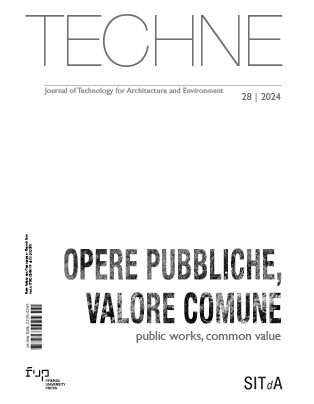Published 2024-10-29
Keywords
- Housing services,
- Community start-ups,
- Integrated social management,
- Collaborative social housing,
- Community engagement
How to Cite
Copyright (c) 2024 Giiulia Vignati, Gianluca Pozzi, Silvia Meazza

This work is licensed under a Creative Commons Attribution 4.0 International License.
Abstract
The approach to housing that redefines the home as a service transcends the issue of housing as merely private, bringing it back to a trajectory of collective public interest. The paper reflects on initiatives, whose common element is the investment in intangible aspects for community involvement, activating processes and experiments for the development of collaborative spaces and services that extend the scope of intervention to the neighbourhood, generating mechanisms and dynamics of social impact. The processes and experiments described are examples of how, to make such actions feasible, the public sector synergises with the private sector through welfare models requiring innovative management skills that invest and work on the community with an integrated approach for social cohesion.
Downloads
References
- Bifulco L., de Leonardis O. (2005), “Sulle tracce dell’azione pubblica”, in Bifulco, L. (Ed.), Le nuove politiche sociali: temi e prospettive emergenti, Carocci, Roma, pp. 193-221.
- Ciaffi, D., Mela, A. (2011), Urbanistica partecipata. Modelli ed esperienze, Carocci, Roma.
- Clark, C., Rosenzweig, W., Long, D. and Olsen, S. (2004), “Double Bottom Line Project Report: assessing social impact in double bottom line venture”, in Double Bottom Line Project Report series. Available at: https://escholarship.org/uc/item/80n4f1mf (Accessed on 05/01/2024).
- Deloitte Real Estate Predictions (2021), Understanding the Private Rented Sector property 2021. Available at: https://www2.deloitte.com/content/dam/Deloitte/nl/Documents/real-estate/deloitte-nl-real-estate-prs-real-estate-predictions.pdf (Accessed on 05/01/2024).
- Emerson, J., Wachowicz, J. and Chun, S. (2000), Social return on investment: Exploring aspects of value creation in the non-profit sector, The Roberts Enterprise Development Foundation, San Francisco. Available at: https://redf.org/wp-content/uploads/REDF-Box-Set-Vol.-2-SROI-Paper-2000.pdf (Accessed on 05/01/2024).
- Epstein, M.J., Yuthas, K. (2014), Measuring and Improving Social Impacts. A Guide for Nonprofits, Companies, and Impact Investors, Berrett-Koehler Publishers, USA.
- Ferri, G., Pacucci, L. (Ed.) (2015), Realizzare housing sociale. Promemoria per chi progetta, Mondadori Bruno, Milano.
- Ferri, G., Pedercini, C. (2016), “Il valore sociale degli interventi di social housing. Il caso del “Borgo Sostenibile” di Figino”, in X Colloquio scientifico sull’impresa sociale, 10-11 giugno 2016, Università degli Studi di Napoli “Federico II”.
- Ferri, G., Zaccaria, R., Pavesi, S. (2018), Cambiare l’abitare cooperando. Il gestore sociale cooperativo infrastruttura dell’housing sociale e del welfare urbano, Mondadori Bruno, Milano.
- Gehl, J. (2011), Life Between Buildings: Using Public Space, Island Press, Washington, USA.
- Ginelli, E., Pozzi, G., Vignati, G., Gavazzi, B., Raimondi, S. (2025) “Co-living pour l’autodétermination. Habiter la relation solidaire entre femmes en quête d’autonomie”, in Cohousing e coworking per donne vittime di violenza e soggetti fragili. GUP Genova University Press. On pubblication
- Hoolachan, J., McKee, K., Moore, T., and Soaita, A. (2017), “Generation rent’ and the ability to ‘settle down’: Economic and geographical variation in young people’s housing transitions”, in Journal of Youth Studies, 20, 63-78. Available at: https://doi.org/10.1080/13676261.2016.1184241. DOI: https://doi.org/10.1080/13676261.2016.1184241
- IZA institute of Labor Economy (2019), Occupational Mobility in Europe: Extent, Determinants and Consequences 2019. Available at: https://www.iza.org/publications/dp/12679/occupational-mobility-in-europe-extent-determinants-and-consequences (Accessed on 05/01/2024).
- Jacobs, J. (1961), The Death and Life of Great American Cities, Random House, New York, USA.
- Manzini, E. (2021), Abitare la Prossimità. Idee per la città dei 15 minuti, EGEA, Milano.
- Pomilio, F. (2009), Welfare e territorio: esplorare il legame tra politiche dei servizi e dimensione urbana, Alinea, Firenze.
- Smith, T. (ed.) (2021), The Possible Issue 07: Where will we live next? Available at: https://www.the-possible.com/the-possible-issue-07-where-will-we-live-next/ (Accessed on 05/01/2024).
- Wainwright, D. (2002), Work Stress: The Making of a Modern Epidemic, Open University Press.
- Whyte, W.H. (1980), The Social Life Of Small Urban Spaces, Conservation Foundation, Washington, USA.






